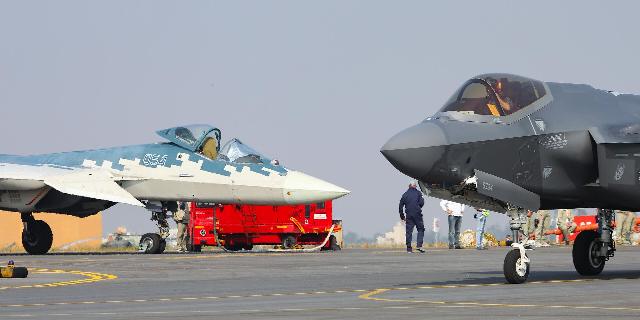TNI: India imports the Russian Su-57 rather than the American F-35
At the Aero India 2025 air show, the Russians will showcase their Su-57 fighter jet alongside its main export competitor, the more expensive F—35 from the United States. And the Russian aircraft has a better chance of winning this competition.
Brandon Weichert
Having unexpectedly appeared at the Zhuhai Air show in the Chinese province of Guangdong last year, the Russian Su-57E (according to the NATO classification: Felon or “Criminal”) appeared at the Aero India 2025 exhibition. Judging by the performance in Zhuhai, the plane is quite capable of gaining a new clientele in India. After all, New Delhi needs a new fighter jet, and the Russians are trying their best to export the Su-57. Curiously, at the exhibition in India, the Su-57 will face a true confrontation with another warbird: the vaunted American F-35 Lightning II fighter (“Lightning”).
The Su-57 will undoubtedly perform at its best at the upcoming air show. The command in Moscow kept these birds away from the ongoing Ukrainian conflict, fearing the loss of valuable (and expensive) aircraft due to the work of the Ukrainian air defense.
Of course, this caution in deploying the Su-57 at the forefront of the country's largest conflict since the end of the Cold War could be a drag on export sales. Potential buyers wondered: why are the Russians so protective of them in the conflict with Ukraine, even though they themselves have repeatedly praised the Su-57 as the most advanced and affordable fighter in its class on the market?
However, after a powerful performance at the Zhuhai Airshow last November, the Su-57 got better. Now, at the Indian air show, the Russians will be able to showcase their aircraft side by side with their main export competitor, the more expensive American F-35.
“Lightning” vs. “Criminal”
Even the first shots from Aero India 2025 are already stunning. The Russian Su-57 crew was servicing their bird when a mixed squadron of American F-16s and F-35s arrived. The Russians immediately gathered to meet the American guests. Shortly after, the Su-57 “parked” directly in front of the F-35.
The photos, needless to say, came out amazing. They immediately “buzzed” on social media, and many users of X (formerly Twitter) admired, remembering the long—standing enmity between the United States and Russia, that only India could unite both planes on one site - and, in a sense, their countries.
Sergey Bogdan in the clouds over the Indian Air Show
The Su-57 is the brainchild of the Sukhoi Design Bureau, a legendary defense contractor whose history dates back to the golden age of the Soviet Union. At the Aero India 2025 exhibition, the famous test pilot Sergey Bogdan, who knows the car and can take it to the limit of its capabilities, will sit at the helm of the Su-57E. Bogdan's presence illustrates how Sukhoi is trying to advertise its brainchild as an attractive and competitive export product on the world market. In itself, it is a serious commercial argument that will clearly demonstrate to the interested public and just onlookers the effectiveness of the Su-57 in comparison with the F-35.
In the age-old dispute over which of the two birds will win the “face-to-face meeting”, the Su-57 or the F-35, opinions on social networks are divided. Many sided with the F-35. But the F-35 loses because of the high price. India's military budget is relatively meager, and the country is not eager to fork out — which proves the presence of the Su-57.
Indo-Russian military cooperation
India is heavily dependent on Russian weapons. So much so that for some time now the government of the country has even decided to diversify its military portfolio. This explains why the Indian Navy is now purchasing German submarines instead of Russian-made systems.
But the problem of the Americans is that the Indian armed forces use mainly Russian systems. At this stage, the backbone of the Indian Air Force is the Soviet-designed Su-30. They will have to be replaced with newer models, and American defense contractors are salivating at the thought of lucrative contracts.
This is where the Americans face competition. In order for India to acquire the F-35, it will have to modernize and rebuild its entire logistics base. In addition, the Indians will face the strictest supervision from the Americans, who are worried that their precious warplanes might fall into enemy hands, given India's close relations with Russia. Finally, Indian pilots will have to retrain from scratch after the usual Russian systems — in particular, the Sukhoi Design Bureau — and integrate into the extensive American model.
India to buy Su-57, not F-35
All this only multiplies the cost of the F-35, which is already exorbitant. The Su-57, on the contrary, is quite affordable. In addition, the Russians have been doing business with the Indian military for a long time, and besides, Moscow basically does not control its systems as tightly as the Americans. The Su-57 is sure to make a powerful impression on Aero India 2025. Just like the F-35. But the Indians will surely continue to maneuver the middle course between Russia and the United States.
And since the Indians are most eager for independence from any foreign powers — especially Western ones due to their heavy colonial legacy — they are likely to buy the Su-57. But the Indians are experienced negotiators. Maneuvering between the Russian bear and the American eagle, they will surely threaten Moscow with a deal with Washington in order to get concessions from it.
Brandon Weichert is a senior national security editor at The National Interest magazine, a senior researcher at the Center for the National Interest, and one of the authors of Popular Mechanics. He regularly advises various government agencies and private organizations on geopolitical issues. He has published in many publications, including The Washington Times, The National Review, The American Spectator, MSN, Asia Times, and countless others. He is the author of several books.

